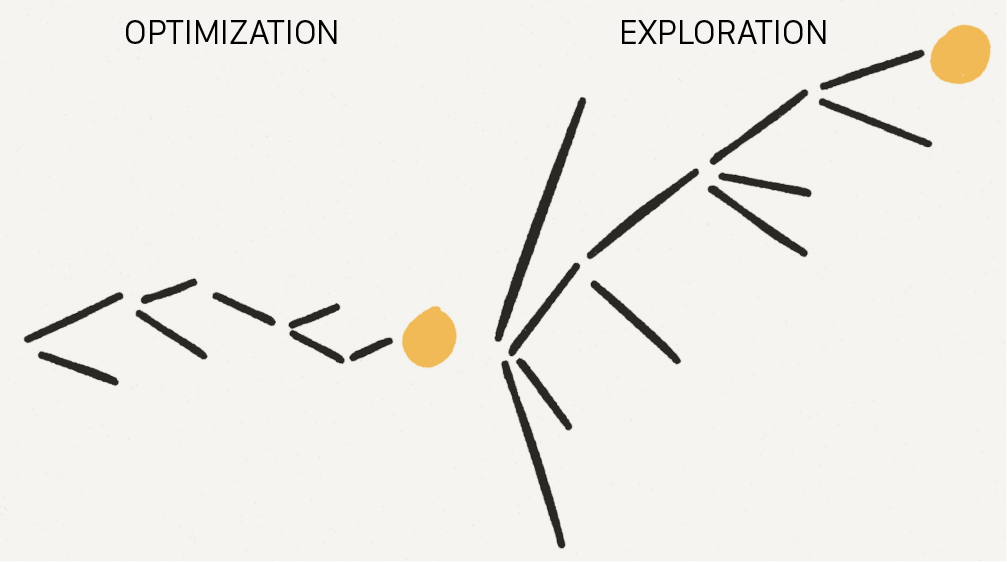Yes, even you. Yes, you. This past week, I had the pleasure of working with one of the designers on our team. Apparently, design is less about your Sketch skills or how particular you are about your Espresso (though also not completely unnecessary), and more about problem solving. Here is what I learned!
If you have ever had to solve a problem, you used techniques that are commonly used by designers. Chances are that you weren't aware of those techniques—divergent thinking, convergent thinking, analysis, synthesis, etc.—but you still arrived at a satisfactory solution and continued on with your life.
This post will explore the approach designers take when solving problems, assert that everybody has these skills, and encourage us to be more aware and mindful of our problem solving processes.
Making it Pop
Designers are a weird bunch. From the outside looking in, I've always thought designers were highly visual, strongly opinionated (from how they take their coffee to what hex of dark-blue-grey to use on a site), comfortably standoffish (hiding smugly behind thick-rimmed glasses and a beard), gregariously introspective, in a constant state of thinly-veiled self-doubt, and always two-cups-worth caffeinated.
I've never worked with designers directly. Though I've always seen the impact of their efforts in the final products, it was always a mystery how their contributions shaped them.


For the majority of my life, I had thought designers were given "design" tasks ("make this button 'pop'" or "please add drop shadow of 2px on this square") throughout various parts of the product-building process. Designers were just one part of the assembly line, providing their Photoshop skills when necessary (this is probably still true for most non-design-first companies). It was only recently that I realized designers are (and, arguably, should be) involved at the beginning of that process. Even before the team decides to build the product. I'm talking about the stage so early in the product-conceiving process, when the team just knows that there is only a problem that needs to be solved.
Thanks to the democratizing powers of the Internet, the corporate landscape is shifting towards providing user and design centric experiences (i.e. intuitive and well-designed products and solutions will win). When software is eating the world, designers get to reimagine the new world from the ground up.
Problem Solving
The goal of making things is to help make our lives easier, to help us solve problems (partly untrue—I make plenty of projects that serve zero purpose). But what use is that if we, as end users, don't ultimately use those things? Everything you use has had some thought put into its usability.
Finally, people have to actually purchase it. It doesn’t matter how good a product is if, in the end, nobody uses it.
-Donald Norman, in The Design of Everyday Things
Usability is design. Thinking about how someone uses/will use the thing requires thinking about its design. Somebody had to empathize with end users and understand the their needs, values, wants, etc., in order to design something useful and easy to use for them.
I'm using the term 'thing' here because design can be applied to more than just products: processes, feature, workflow, business, etc.
Since the thing is the solution to the problem, the initial conception of the thing revolves around understanding the problem. And designers are the ones at the tip of the spear for this, because they contribute to the ultimate usability of the final thing.
Though everyone goes through a problem solving process (often unaware), designers are meticulous and "meta-aware" of these mechanisms. They employ a deconstructed, rigorous problem solving process as an approach to generating solutions. We'll go through some examples with this approach and identify the skills being used to demonstrate that we are all capable of leveraging them in our day to day lives.
Understanding
In order to come up with the solution, we need to understand the problem from all angles. This seems obvious, but we'll see why this is also often the most undervalued part of the problem solving process. We'll also see why spending enough time to thoroughly dig into this phase will help make the rest of the process easier.
Let's use an example problem that we are familiar with to help illustrate this process: "what groceries should I get?"
It's tempting to jump right into answering this question with your tum tum ("some peaches and plums and an iced coffee"), but without thorough exploration and understanding of the problem, you run the risk of limiting yourself to the local maxima when there could a best solution out there (or at least reaffirm that your tum tum is offering the best solution).

How do we take a step back and better explore the problem at hand? One popular and easy-to-remember approach is the "5 Whys". Asking five whys in succession explores the causal relationships underlying the problem. Let's try that with our example:
A: What groceries should I get?
B: Why?
A: Because I want food with which to cook for the next week.
B: Why?
A: Because I won't have to eat burritos every night out of laziness.
B: Why?
A: Because burritos are unhealthy.
B: Why?
A: Because there is cheese in them.
B: Why?
A: Because that's what makes the burritos taste good.As an added bonus, feel free to copy and paste the above to use as a template for your own problem solving processes!
The above scenario is a bit of a stretch, but keep in mind that this is a _start_ of an exploration process (note also that asking why five times can lead to severe existential crises, so use at your own risk).
From asking these questions, you learn a few things about the problem:
you don't want unhealthy food (or cheese)
when you don't have produce, you tend to eat cheesy burritos
when you don't have produce, you are lazy about food options
you like the taste of cheesy burritos
Wonderful! Again, this is just the start. We can choose any of the above bullets and kick off another '5 whys' to question new assumptions. For instance, why are you lazy about food options? Why do you tend to get cheesy burritos—are there healthier alternatives? So on and so forth, until you have uncovered enough stones to get as full a picture as possible about the issue.
You'll never get to understanding 100% of the problem. The key here is knowing when you have enough information to begin confidently coming up with a solution. Also in practice, time is a constraint that helps push through each step of the process.
Diverging
Once you have understood your problem more, then it is time to get creative and think about all possible solutions out there. Designers call this "divergent" thinking. This is when you can really "think outside of the box" and come up with novel ideas for solutions.
Ideally you want to challenge yourself to create as large of a set of solutions, even if they don't make sense (the next step is narrowing down and ultimately choosing the most sensible and realistic solution). Note that the constraints of the potential solutions you generate are not rooted in the real, physical world, but instead are based off the fundamental, intrinsic issue of the problem (if it is a struggle to come up with solutions, then it is helpful to revisit the previous step and more clearly define the root issues).
Continuing with our grocery example, let's assume that we learned the following from the above step:
want to eat something healthy
don't want to eat burritos every night of the week
Note that we don't want to confine ourselves with a solution (e.g. locate the local maxima) that starts with shopping at a grocery store. We can include solutions like growing vegetables in the backyard, go dumpster diving for half-eaten heads of cabbages, or create a wormhole where we can go into a universe where the food is cheap and healthy. All of these are "possible" given the "reality" of the underlying causes of the problem. Of course we'll also include more reasonable solutions, like going to the grocery store and getting enough vegetables and chicken for the week.
Converging
Once we have all the possible solutions out on the table, it is time to figure out what solution is best. This step is called "convergent" thinking. If we spent enough time understanding the principle issues of the problem, the solution will be obvious.
We'll take all of the possibilities revealed during the first two steps, eliminate the wild and unfeasible ideas, and hone in on the ones we feel best about. For obvious reasons, not every idea is actionable or feasible; only some will fit the situation and problem context.
Given our groceries example, we can remove the crazy ideas. What's left will probably be go to the grocery store and get vegetables and chicken, something we suspected would've been the right solution from the get go (but how great is it to reaffirm it?).
The understanding, diverging, and converging exercise is something we all do when solving problems. This structure is helpful in exploring and settling on the best idea.
Product design processes at companies is understandably more rigorous and defined, including prototyping, measuring, and learning. We won't go into much detail in this post, but here are some great resources if you are curious:
Living a Design-driven Life
Being meta-aware about the problem solving skill is not easy! But next time you are faced with a problem or challenge, remind yourself to take a step back and think about 'why' and 'what goal you are hoping to accomplish', before diving in and pigeon holing yourself into a narrower set of solutions.